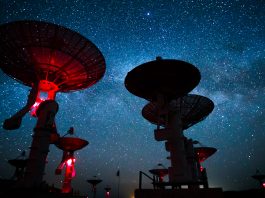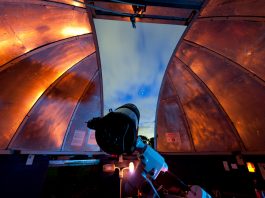Mathieu de Naurois, H.E.S.S. Deputy Director at CNRS, outlines the use of the H.E.S.S. telescopes in detecting the kiloparsec-sized VHE gamma-ray emission of Centaurus A.
In recent decades, the Universe has been probed in the light of very high energy (VHE) gamma-rays, which has enabled the identification of many different kinds of galactic sources, distant quasars, and other active galaxies. Curiously, those distant and extremely luminous sources of gamma-ray emission are very often found to vary within weeks or days – sometimes even as fast as hours. It was therefore concluded that the highly energetic emission originates from very compact regions – very likely linked to a massive black hole in the centre of the host galaxy.
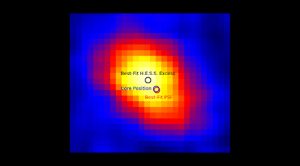
In June, the H.E.S.S. collaboration demonstrated for the very first time that these very energetic sources are actually gigantic in size.1 The H.E.S.S. telescopes have now revealed that the gamma-ray emission of the most nearby active Galaxy, the famous source Centaurus A, is actually extended over many thousands of light-years. The discovery was made possible through the elaborate analysis performed on an extended data set obtained with the sensitive H.E.S.S. array.

© ESO
Angular resolution
Unlike most fields of astrophysics were imaging optics of impinging radiation permit sharper images, VHE gamma-rays are recorded indirectly through the Cerenkov light emitted by air showers that have been launched when the energetic gamma-rays interact in the atmosphere. This process limits the precision in reconstructing the direction of the original photons, resulting in a ‘point-spread function’ (characterising the angular resolution) which is several arc-minutes in diameter (the resolution depends on the photon energy and the layout of the telescope array). As a result, most of the sources that appear spatially extended in VHE gamma-ray images are galactic sources, a few- to tens of parsecs across and a few kiloparsec away from Earth. Diameters of extragalactic objects have not been directly measured in the VHE domain. Determining the size of the emitting region in Centaurus A has been a major technical breakthrough, making the jet of Centaurus A the physically largest emitter of very high energy gamma-rays that has had its size measured explicitly. This measurement has a number of important scientific implications.
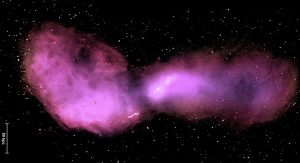
Centaurus A
The H.E.S.S. collaboration observed the radio galaxy Centaurus A, also known as NGC 5128, for over 200 hours at unparalleled resolution, enabling them to identify the region emitting the very high-energy radiation while studying the trajectory of the plasma jets. The source is a prominent southern hemisphere galaxy with a prominent dust-belt (indicative of a recent galaxy merger) and a set of giant, multiple radio-lobes, stretching over one megaparsec (see Fig. 2 and 3).2
As the nearest active galaxy to the Milky Way, Centaurus A is favourable for such a morphological study of jet emission. The radio jets of Centaurus A were also detected in the X-ray band, despite the high column depth of neutral hydrogen associated with the dust belt.3 This allows broad-band characterisation of the synchrotron emission radiated by the energetic particles within the jet. The high angular resolution in the radio and X-ray bands show the jet to include a large number of compact knots (see Fig. 4), which are thought to be sites of re-acceleration of the charged particles responsible for the high-energy emission. X-ray studies had already suggested changes in the synchrotron flux of the X-ray jet some 30 years ago4 but most models concluded that the energy density would be insufficient to detect extended VHE gamma-ray emission.5 The surprise detection of extended gamma-ray emission with H.E.S.S. demonstrates that particle acceleration even up to the highest energies does not take place solely in the vicinity of the black hole but also along the entire length of the plasma over a distance of several thousand light-years. It hence calls for a revision of models describing the reacceleration by stochastic processes along the jet.
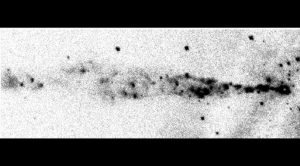
The recognition of the VHE gamma-ray being extended also implies that the integrated emission may result from regions with rather different physical characteristics. Following up on the original identification of Centaurus A as a VHE radio galaxy,6 the gamma-ray spectrum has been studied from MeV to TeV energies and was found to exhibit peculiar features (so-called ‘breaks’,7 which may be related to the fact that the unresolved nucleus and the extended jet contribute to the overall emission in an energy-dependant way). A more detailed study is challenging in view of the rather different angular resolutions in different energy bands (see Fig. 5).
At much larger angular scales (degrees), the outer lobes thought to have been fed by the jet outflow have been detected in the MeV band using Fermi-LAT data8 – a phenomenon likely to be explained by Compton upscattering of the microwave background by the relativistic electrons in the lobes.
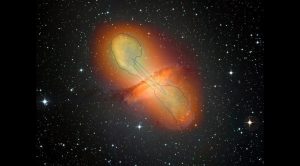
Cosmological Implication
Centaurus A is the most nearby major galaxy and yet one of the dimmest VHE emitters known, making it a rather low-luminosity gamma-ray active galactic nucleus. Nonetheless, the discovery of extended VHE jet emission may have profound cosmological implications. If characteristic of the class, the detection suggests that many radio galaxies with extended jets accelerate electrons to extreme energies and might emit gamma-rays, possibly explaining the origins of a substantial fraction of the diffuse extragalactic gamma background radiation.
These findings thus provide important new insights into cosmic gamma-ray emitters, and in particular about the role of radio galaxies as highly efficient relativistic electron accelerators. Due to their large number, it would appear that radio galaxies collectively make a highly significant contribution to the redistribution of energy in the intergalactic medium.
References
- The H.E.S.S. Collaboration. Nature, 582, 356–359 (2020)
- Israel, F.P. Astron. Astrophys. Review, 8, 237-278 (1998)
- Kraft, R.P., Forman, W.R., et al. Astrophys. J. Lett., 531, L9–L12 (2000)
- Döbereiner, S., Wagner, S.J., et al. Astrophys. J. Lett., 470, L15 (1996)
- Hardcastle, M.J. and Croston, J.H. Mon. Not. R. Astron. Soc. 415, 133–142 (2011)
- Aharonian, F. et al. (The H.E.S.S. Collaboration). Astrophys. J. Lett., 695, L40–L44 (2009)
- Abdalla, H. et al. (The H.E.S.S. Collaboration). Astron. Astrophys. 619, A71 (2018)
- Abdo, A. A. et al. (Fermi-LAT Collaboration). Science, 328, 725–729 (2010)
Mathieu de Naurois
H.E.S.S. Deputy Director
CNRS – the French National Centre for Scientific Research
contact.hess@hess-experiment.eu
Tweet @hesstelescopes
www.mpi-hd.mpg.de/hfm/HESS
Please note, this article will also appear in the third edition of our new quarterly publication.



